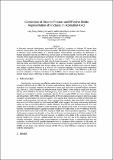Comparison of Discrete Fracture and Effective Media Representation of Fractures on Azimuthal AVO
Author(s)
Zhang, Yang; Chi, Shihong; Willis, Mark E.; Burns, Daniel R.; Toksoz, M. Nafi
DownloadZHANG.pdf (335.1Kb)
Other Contributors
Massachusetts Institute of Technology. Earth Resources Laboratory
Metadata
Show full item recordAbstract
In fractured reservoir development, azimuthal AVO (AVOaz) properties of reflected PP waves from reservoir tops are often used to infer fracture properties. The fracture parameter inversion is based on either an effective media model (EMM) or a discrete fracture model (DFM). We address the differences in fracture properties that may be inferred by AVOaz based on the two models. For the DFM we focus on fractures whose length and spacing are comparable to the seismic wavelength. First, we compute the elastic parameters describing the fractured reservoir for each type of model. Then we synthesize seismic data using a finite-difference program for both sets of elastic parameters. By performing AVOaz analysis, we find that EMM and DFM predict different offsets for maximum AVOaz magnitudes. The DFM results show larger AVOaz magnitude with farther offsets, and phase changes at offsets larger than 35 degrees may indicate compliant fractures in a reservoir. For compliant fractures, the fracture strike determined using AVOaz effect based on the EMM is opposite to that from the DFM. This difference could cause incorrect estimation of fracture orientation if the EMM is used to interpret data from a reservoir with discrete fracture zones. DFM may be better suited for modeling wavelength-scale fractures.
Date issued
2005Publisher
Massachusetts Institute of Technology. Earth Resources Laboratory
Series/Report no.
Earth Resources Laboratory Industry Consortia Annual Report;2005-09